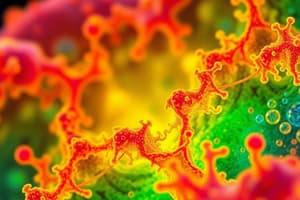Podcast
Questions and Answers
Which type of microscopy uses a beam of light to examine small structures?
Which type of microscopy uses a beam of light to examine small structures?
- Transmission Electron Microscopy
- Light Microscopy (correct)
- Electron Microscopy
- Scanning Electron Microscopy
What is the purpose of fixation in preparing human tissue for microscopy?
What is the purpose of fixation in preparing human tissue for microscopy?
- Creating 3D images
- Preservation of specimens (correct)
- Highlighting vascular structures
- Cutting specimens into thin slices
Which staining technique involves a negatively charged stain binding to positive cellular components?
Which staining technique involves a negatively charged stain binding to positive cellular components?
- Gram Stain
- Neutral Stain
- Acidic Stain (correct)
- Basic Stain
Which type of electron microscopy provides 3D images of entire surfaces?
Which type of electron microscopy provides 3D images of entire surfaces?
What imaging technique uses electromagnetic waves of very short length?
What imaging technique uses electromagnetic waves of very short length?
What is another name for Computed Tomography (CT)?
What is another name for Computed Tomography (CT)?
Which imaging technique uses high-frequency sound waves?
Which imaging technique uses high-frequency sound waves?
Which of the following imaging techniques is best for visualizing soft tissues?
Which of the following imaging techniques is best for visualizing soft tissues?
Flashcards
Microscopy
Microscopy
Examining small structures using a microscope.
Fixation
Fixation
Preservation of specimens for microscopic examination.
Sectioning
Sectioning
Cutting specimens into thin slices for microscopy.
X-Ray Images
X-Ray Images
Signup and view all the flashcards
Computed Tomography (CT)
Computed Tomography (CT)
Signup and view all the flashcards
Digital Subtraction Angiography (DSA)
Digital Subtraction Angiography (DSA)
Signup and view all the flashcards
Positron Emission Tomography (PET)
Positron Emission Tomography (PET)
Signup and view all the flashcards
Magnetic Resonance Imaging (MRI)
Magnetic Resonance Imaging (MRI)
Signup and view all the flashcards
Study Notes
Microscopy
- Microscopy is the process of using a microscope to examine small structures.
- Light microscopy uses a beam of light and provides lower magnification.
- Electron microscopy utilizes electrons for higher magnification.
Preparing Tissue for Microscopy
- Fixation preserves specimens.
- Sectioning cuts specimens into thin slices.
- Acidic stains, negatively charged, bind to positive cellular components.
- Basic stains, positively charged, bind to negative cellular components.
Types of Electron Microscopy
- Scanning Electron Microscopy (SEM) provides 3D images of entire surfaces.
- Transmission Electron Microscopy (TEM) displays inner structures like crystal morphology.
- Artifacts are minor distortions in preserved tissues that do not represent living tissues.
Radiographic Anatomy
- Radiographic anatomy studies anatomy using imaging techniques like X-rays, CT scans, and MRIs.
- It's important for non-invasive visualization in clinical practice.
Clinical Anatomy—Medical Imaging Techniques
- Key medical imaging techniques include X-Ray Images, Computed Tomography (CT), Angiography, Positron Emission Tomography (PET), Sonography (Ultrasound), and Magnetic Resonance Imaging (MRI).
X-Ray Images
- X-Ray Images uses utilizes electromagnetic waves of very short length.
- X-Rays are most effective for visualizing bones and abnormal dense structures.
Computed Tomography (CT)
- Computed Tomography (CT), also known as axial tomography.
- CT generates detailed body section images using successive X-rays around the circumference of the patient.
Digital Subtraction Angiography (DSA)
- Angiography highlights vascular structures using contrast mediums.
- DSA captures images before and after contrast injection.
- A computer analyzes the images to identify blockages in arteries.
Positron Emission Tomography (PET)
- Positron Emission Tomography (PET) creates images by detecting radioactive isotopes administered into the body.
Ultrasound Imaging (Sonography)
- Ultrasound Imaging (Sonography) uses high-frequency sound waves that echo off body tissues.
- Primarily used for determining the age of a developing fetus.
Magnetic Resonance Imaging (MRI)
- Magnetic Resonance Imaging (MRI) produces high-contrast images focused on soft tissues.
- MRI allows differentiation of body structures based on water content.
Overview
- Subdisciplines of anatomy are included in this course.
- Microscopy and Cytology techniques are included in this course.
- Radiographic imaging in clinical anatomy is included in this course.
- Laboratory practicals and safety are included in this course.
- Terminology and microscope care are included in this course.
Studying That Suits You
Use AI to generate personalized quizzes and flashcards to suit your learning preferences.
Description
Explore microscopy techniques: light and electron microscopy. Learn tissue preparation methods like fixation and sectioning. Discover radiographic anatomy and its importance in clinical visualization.



